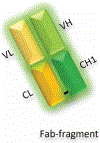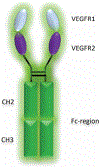Efficacy and safety of intravitreal anti-VEGF therapy in diabetic retinopathy: what we have learned and what should we learn further?
- PMID: 35818801
- PMCID: PMC10863998
- DOI: 10.1080/14712598.2022.2100694
Efficacy and safety of intravitreal anti-VEGF therapy in diabetic retinopathy: what we have learned and what should we learn further?
Abstract
Introduction: Diabetic retinopathy (DR) is one of the most frequent microvascular complications of diabetes that can lead to blindness. Laser treatment has been the gold standard treatment for diabetic macular edema (DME) and proliferative diabetic retinopathy (PDR) for many years. Recently, the role of vascular endothelial growth factor (VEGF) has been established in the pathogenesis of DR, and the use of intravitreal anti-VEGF therapy has gained popularity for the management of DR.
Areas covered: This review includes a brief overview of the efficacy and safety of currently available (bevacizumab, ranibizumab, and aflibercept) and potential future (brolucizumab, faricimab, and KSI-301) anti-VEGF agents in patients with DR based mainly on publicly available data from phase 1, 2 and 3 clinical trials.
Expert opinion: Clinical trials investigating the efficacy of intravitreal bevacizumab, ranibizumab, and aflibercept injections demonstrated favorable functional and anatomical outcomes in patients with DME. Moreover, the use of these anti-VEGF agents showed a significant improvement in the severity of DR. Recent clinical research for future anti-VEGF molecules aims to provide higher target-protein binding affinity and prolonged therapeutic effect. Brolucizumab, faricimab, and KSI-301 are three novel anti-VEGF agents that demonstrate promising data for the management of DME and potentially DR.
Keywords: Aflibercept; anti-vascular endothelial growth factor; bevacizumab; diabetic macular edema; diabetic retinopathy; ranibizumab; vascular endothelial growth factor.
Conflict of interest statement
QD Nguyen serves on the scientific advisory boards for Bausch and Lomb, Bayer, Genentech/Roche, Regeneron, Novartis and Santen. QD Nguyen has also chaired the steering committee for the RISE and RIDE studies and was on the steering committee for the VISTA Study, as well as other studies sponsored by Genentech and Regeneron. DV Do serves on the scientific advisory boards for Allergan, Kodiak, Genentech and Regeneron. The authors have no other relevant affiliations or financial involvement with any organization or entity with a financial interest in or financial conflict with the subject matter or materials discussed in the manuscript apart from those disclosed.
Figures



References
-
- Fong DS, Aiello L, Gardner TW, et al. Retinopathy in diabetes. Diabetes Care. 2004;27Suppl 1:S84–7. - PubMed
-
- Antonetti DA, Klein R, Gardner TW. Diabetic retinopathy. N Engl J Med. 2012 Mar 29;366(13):1227–1239. - PubMed
-
- Cheung N, Mitchell P, Wong TY. Diabetic retinopathy. Lancet. 2010 Jul 10;376(9735):124–136. - PubMed
-
- Moss SE, Klein R, Klein BE. The 14-year incidence of visual loss in a diabetic population. Ophthalmology. 1998;105(6):998–1003. - PubMed
-
- Stitt AW, Curtis TM, Chen M, et al. The progress in understanding and treatment of diabetic retinopathy. Prog Retin Eye Res. 2016;51:156–186. - PubMed
Publication types
MeSH terms
Substances
Grants and funding
LinkOut - more resources
Full Text Sources
Other Literature Sources
Medical
